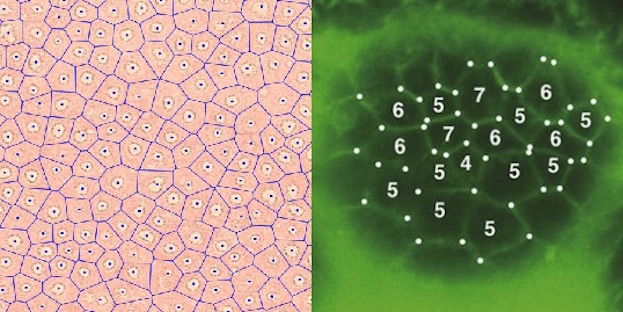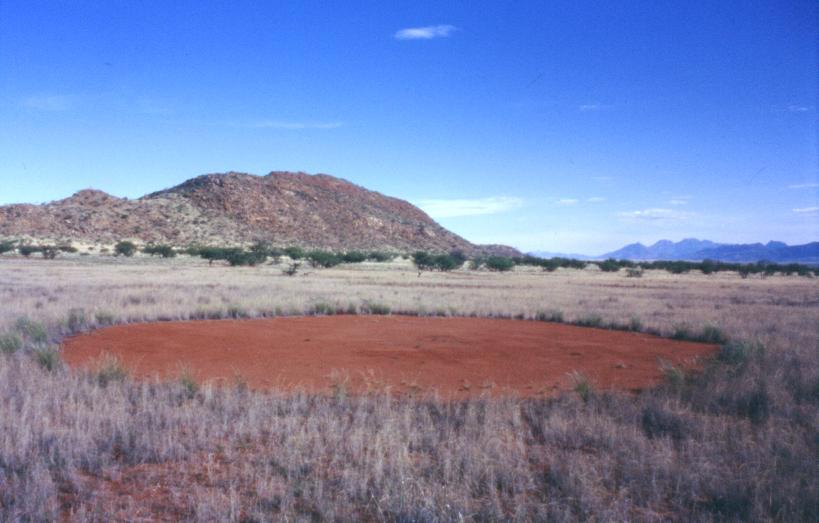Mysterious Desert Fairy Circles Share Pattern with Skin Cells

Dotting the arid grasslands of Namibia, fairy circles have long baffled scientists as to how these round grassy patches form and why they disappear for seemingly no reason. Their mysterious nature has perhaps deepened with a new finding that the circles share a mathematical pattern with the skin cells of zebrafish.
"It's a completely amazing, strange match," one of the study's researchers, Robert Sinclair, a professor of mathematical biology at the Okinawa Institute of Science and Technology Graduate University in Japan, said in a statement.
It's unclear how these fairy rings, which are different from mushroom rings, form in the desert. But they're impossible to miss; each barren patch of earth is surrounded by short grass, and they speckle the desert like craters on the moon, the researchers said. Scientists are racing to figure out this strange phenomenon, and have offered several still-unproven theories of what creates the circles, including that of rolling zebras, differences in soil nutrients and termites.
The researchers of the new study took a different approach to understanding this phenomenon. They realized that like skin cells, fairy circles have a life cycle (they are born, grow and then die) and they could be affected by competition for space-related resources. So they decided to look at the macroscopic pattern of fairy circles that dot the landscape and compare it with the microscopic distribution of skin cells, finding the two share a remarkably similar pattern. [In Photos: Amazing 'Fairy Circles' of the Namib Desert]
A pattern that appears on both macroscopic and microscopic levels in nature is virtually unheard of, they said.
"It is still difficult to say why exactly they are similar, but the fact that they are similar is already very important," Sinclair said. "This is suggesting there may be such types of patterns that cover really different size scales."
For the study, Sinclair and his colleague compared the number of neighbors surrounding each fairy circle with those of skin cells. They used satellite images of the fairy circles along with a computer program to draw lines halfway between each pair of circles to give them invisible boundaries, like cell walls. The program then counted how many neighbors bordered each dusty circle.
Get the world’s most fascinating discoveries delivered straight to your inbox.
The researchers also used an analysis from a 2014 study published in the journal Biology Open that examined the cell geometry of the skin covering a zebrafish lens.
The results were virtually indistinguishable. The majority of both the fairy circles and the cells had six neighbors. What's more, the percentage of fairy circles with four, five, six, seven, eight and nine neighbors is almost identical for both the fairy circles and skin cells, the researchers found.
"I didn't expect it to be so close," Sinclair said. "We spent a lot of time checking because it really looked too close to believe."
The patterns may be similar because both skin cells and the circles in the Namib Desert are fighting for space, the researchers said. If this is true, it may help scientists learn more about systems by analyzing their geometric patterns, they added. For instance, such patterns might help them look for signs of life on other planets.
Examining patterns could also help researchers studying ecology and biology in general. For example, understanding a large pattern, such a spiraling galaxy, may help scientists understand a similar one on a smaller scale, such as a honeycomb. "Otherwise, we need a whole new theory for each type of system we study, and may miss general principles, or, as some say, not see the forest for the trees," Sinclair said.
The study is published in the June issue of Ecological Complexity.
Follow Laura Geggel on Twitter @LauraGeggel. Follow Live Science @livescience, Facebook & Google+. Original article on Live Science.

Laura is the managing editor at Live Science. She also runs the archaeology section and the Life's Little Mysteries series. Her work has appeared in The New York Times, Scholastic, Popular Science and Spectrum, a site on autism research. She has won multiple awards from the Society of Professional Journalists and the Washington Newspaper Publishers Association for her reporting at a weekly newspaper near Seattle. Laura holds a bachelor's degree in English literature and psychology from Washington University in St. Louis and a master's degree in science writing from NYU.



